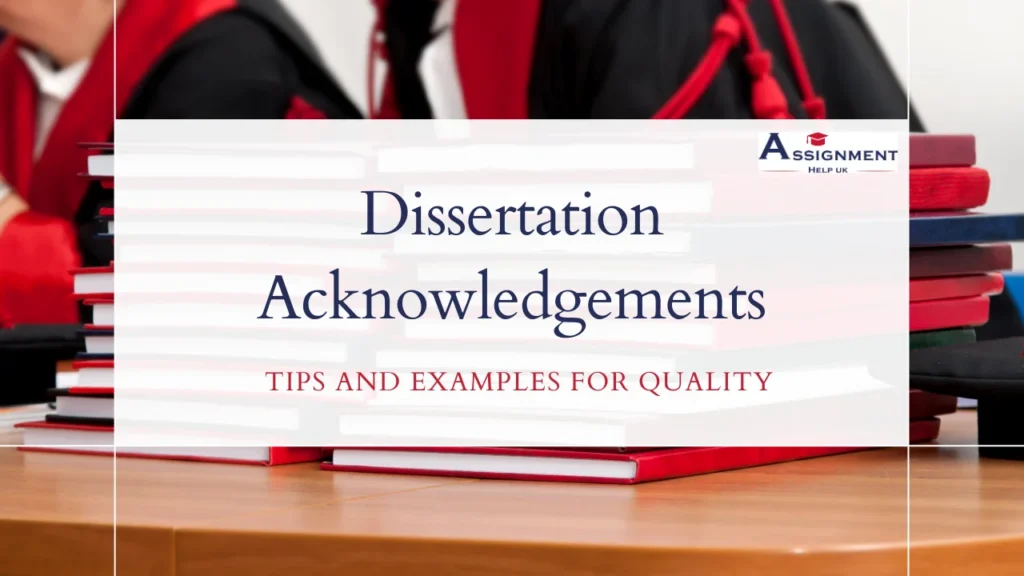Dissertation Acknowledgements: Tips and Examples for Quality
Home / Dissertation Acknowledgements: Tips and Examples for Quality Table of Contents Thesis and Dissertation Acknowledgements You should properly develop an acknowledgements section. Do not forget to drop those who helped you through the thick and thin of this process. You can address several people such as friends, family members, research participants, classmates, editors, colleagues, librarians, laboratory assistants, professors, supervisors, and other funding bodies. Do not bring your casual friends to the list as it can tarnish the quality of your paper. Must Use Full Names in Acknowledgment It is customary to be thankful at the start who has given valuable advice in your thesis or dissertation completion. Full names must be mentioned. Your written paper should reflect a specific professor’s guidelines. This is why you should use their full names and give where credit is due. Make sure you stick to the acknowledgement format for the thesis or dissertation. Covering Friends and Family Usually, family comes first in giving you moral and financial support which sets your direction towards dissertations. Then, the second spot goes to friends who give you an energy boost and support you throughout the tough process of writing a dissertation. Friends are crucial as they help you write your dissertation and play a central role in writing your thesis or dissertation. This is the main step for how to write acknowledgements for dissertations. Do not Forget Supervisors Mentors and supervisors must be mentioned even if they do not provide enough support. For example, students may think that their supervisors did not help them much but mentioning their names in the acknowledgements is still necessary. How to Write a Dissertation Acknowledgement? A proper hierarchy is to be followed when it comes to writing dissertation acknowledgements. For example: your funders, then supervisors, then academicians and advisors, then colleagues, and lastly family and friends. Much like how a table of contents is designed. Without the support of my funders, I would not have. I would also like to thank my advisors and mentors. Without all these people, I could never. Proofread as a Last Step The acknowledgements section of your thesis or dissertation must be proofread. It should not be seen as a snub. It is said that one-time reading is not enough and you need to be vigilant so you can write acknowledgements without any fatal error. Even pets can be included in your dissertation acknowledgments along with people who contributed to your work massively. Dissertation Acknowledgements Examples There are frequently asked questions about how should one write dissertation acknowledgements. The following examples of dissertations can give you a fair idea of how to thank in your dissertation acknowledgments. Example 1 I am glad that I have availed of the opportunity to thank the following: David K., Engineer, County Council Conal M., VS Limited And not to mention my friends, Ali and Salma, as it’s essential to mention their hefty support. My partners or family offered equal support in the completion of my project. I learned how to write Example 2 Not to mention, my personal feelings for someone special. Not to mention, thank you to my supervisor, Mr. Robert, and thanks to my family. Example 3 I would also like to acknowledge that my academic pursuit and its success relied heavily on my supervisor. Dr Natasha, and anyone else. I would write thesis or dissertation acknowledgements without mentioning her. My funder, Mr Rosh, has also played a significant role in my research and dissertation. Worried, who will write your Term Paper? Get In touch with Us Now! Click here Dissertation Acknowledgements in the UK Universities Students across the world feel challenged when it comes to writing dissertation acknowledgements and there is a good reason for that. The beginning of your thesis or dissertation acknowledgements must be the visible connection to your work. Students from some of the most reputable UK universities – such as the University of Bristol or the University of Sussex – also approach Assignment Help UK for more information on dissertation acknowledgements. Conclusion The dissertation acknowledgements are a necessary part of your work. Do not exclude friends, family members, research participants, classmates, editors, colleagues, librarians, laboratory assistants, professors, supervisors, and other funding bodies. The most important of these people must be included at the very beginning. Do not miss out on acknowledgement if you want your dissertation to succeed. Add Your Heading Text Here Please enable JavaScript in your browser to complete this form.Please enable JavaScript in your browser to complete this form.Name *Email *Phone NumberWhat Do You Need Help With? Submit









